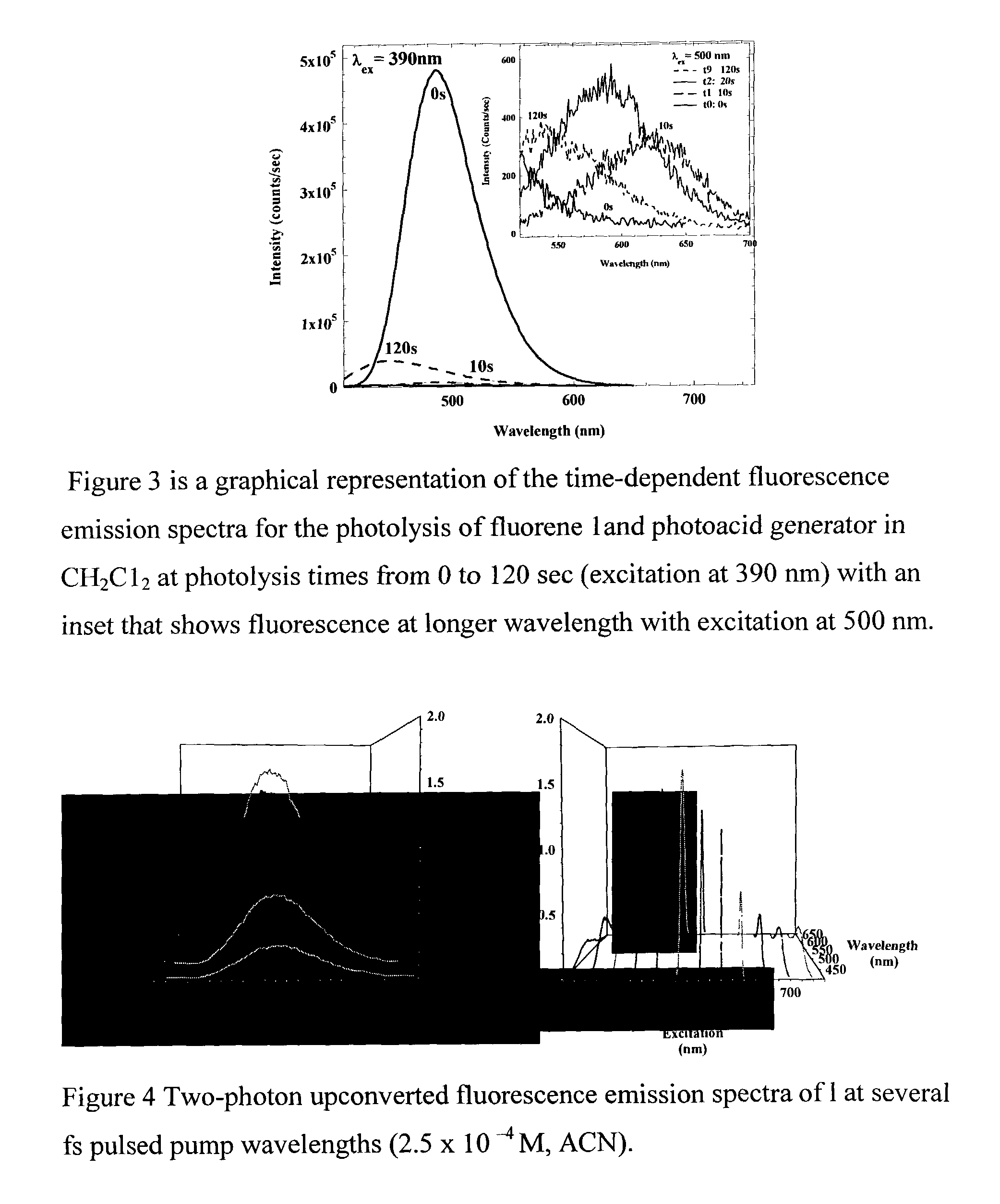Photosensitive polymeric material for worm optical data storage with two-photon fluorescent readout
a polymer material and optical data technology, applied in the field of two-photon fluorescent readout of photosensitive polymeric material for worm optical data storage, can solve the problems of inconvenient long-term use, out-of-focus excitation, and undergo photobleaching and photodegradation, and achieve high photosensitivity, high density optical, and increase data storage and readout versatility.
- Summary
- Abstract
- Description
- Claims
- Application Information
AI Technical Summary
Benefits of technology
Problems solved by technology
Method used
Image
Examples
example 1
Synthesis of 7-benzothiazol-2-yl-9,9-didecylfluoren-2-ylamide (16)
[0193]In a 50 mL 3-neck reaction flask, fitted with a mechanical stirrer, N2 inlet, and stopper, was placed 2,7-dicyano-9,9-didecylfluorene (0.68 g, 1.36 mmol), 2-aminothiophenol (0.34 g, 2.73 mmol) and 5.38 g of polyphosphoric acid (PPA). 2,7-Dicyano-9,9-didecylfluorene was prepared in two steps from fluorene (purchased from Aldrich) by reaction first with bromodecane, then CuCN. The reaction was slowly heated to 80° C., by which time complete dissolution had occurred. On stirring for 5 h at 80° C., the temperature was raised to 120° C. and stirred for 24 h, at which time the reaction mixture turned yellow-orange. The temperature was raised to 140° C. for 40 h. The reaction mixture was cooled and poured into water to precipitate the yellow solid. The crude product was then stirred in 50% ammonium hydroxide (NH4OH) for 1 h, filtered, and washed with water. It was dried, and purified by recristallization using (60:40 h...
example 2
Synthesis of 7-cyano-9,9-didecylfluoren-2-ylamine (18)
[0194]7-Cyano-9,9-didecyl-2-nitrofluorene (0.88 g, 1.87 mmol) was dissolved in a mixture of THF (3 mL) and EtOH (8 mL) at room temperature. 7-Cyano-9,9-didecyl-2-nitrofluorene was prepared in three steps from fluorene (purchased from Aldrich) by reaction first Nitric and sulfuric acid, then bromodecane, and finally CuCN. To this was added graphite, and the mixture was degassed under vacuum and N2. The mixture was heated to 90° C. under N2 and hydrazine hydrate (1.05 g, 32.89 mmol) was added dropwise via syringe. TLC analysis using (60:40) hexanes / CH2Cl2, indicated reduction was complete after 48 h. The reaction mixture was filtered, concentrated, and the resulting yellow-orange oil was passed through a Si gel column, using (70:30) hexanes / CH2Cl2, providing 0.62 g of yellow solid (75.4% yd; mp=46–47° C.). Anal. Calcd for C34H50N2: C, 83.99%, H, 10.35, N, 5.75%,. Found: C, 83.84%, H, 10.50%, N, 5.73%. 1H NMR (300 MHz, CDCl3) δ: 7.5...
example 3
Synthesis of 2-(9,9-didecyl-7-cyanofluorene-2yl)diphenylamine (19)
[0195]7-Cyano-9,9-didecylfluoren-2-ylamine (0.4 g, 0.9 mmol) was subjected to an Ullmann condensation reaction with iodobenzene (0.92 g, 4.5 mmol) at 180° C. for 48 h. The 2-amino-7-cyano-9,9-didecylfluorene was prepared directly from 7-cyano-9,9-didecyl-2-nitrofluorene (reported in the previous example) by reduction using graphite and hydrazine hydrate. The synthetic procedures were performed in analogy to the procedures given for 3. A bright yellow viscous oil was obtained after column chromatographic purification (0.48 g, 89% yd). Anal. Calcd for C46H58N2: C, 86.47%, H, 9.14%, N, 4.38%. Found: C, 86.72%, H, 9.14%, N, 4.38%. 1H NMR (300 MHz, CDCl3) δ: 7.57 (m, 4H), 7.25 (t, 4H), 7.08 (m, 8H), 1.84 (m, 4H), 1.11 (m, 28H), 0.88 (t, 6H),0.60(m,4H). 13CNMR(300 MHz, CDCl3)δ: 150.0, 148.3, 146.1, 144.7, 142.8, 130.7, 128.6, 126.5, 123.3, 121.6, 120.3, 120.0, 118.7, 116.5, 115.2, 105.8, 52.5, 37.1, 29.0, 27.0, 26.7, 26.7, ...
PUM
| Property | Measurement | Unit |
|---|---|---|
| glass transition temperature | aaaaa | aaaaa |
| temperature | aaaaa | aaaaa |
| temperature | aaaaa | aaaaa |
Abstract
Description
Claims
Application Information
 Login to View More
Login to View More - R&D
- Intellectual Property
- Life Sciences
- Materials
- Tech Scout
- Unparalleled Data Quality
- Higher Quality Content
- 60% Fewer Hallucinations
Browse by: Latest US Patents, China's latest patents, Technical Efficacy Thesaurus, Application Domain, Technology Topic, Popular Technical Reports.
© 2025 PatSnap. All rights reserved.Legal|Privacy policy|Modern Slavery Act Transparency Statement|Sitemap|About US| Contact US: help@patsnap.com



